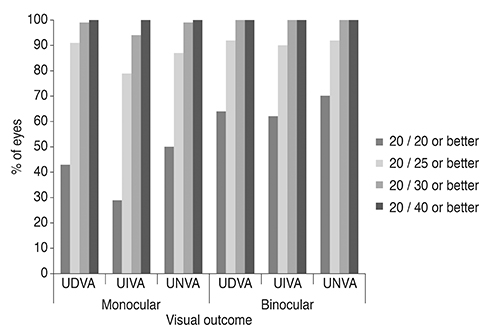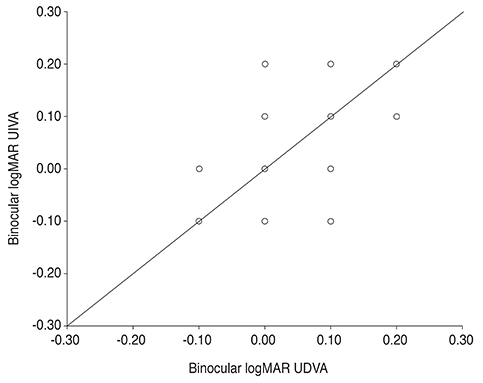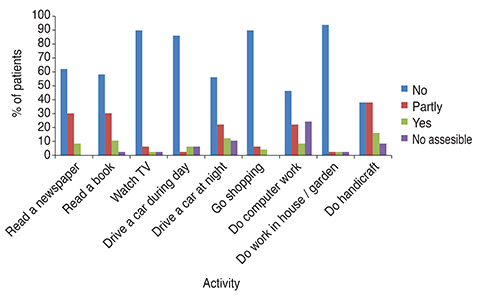Korean J Ophthalmol.
2016 Jun;30(3):180-191. 10.3341/kjo.2016.30.3.180.
Visual Outcomes, Patient Satisfaction and Spectacle Independence with a Trifocal Diffractive Intraocular Lens
- Affiliations
-
- 1International Vision Correction and Research Centre (IVCRC) & David J Apple International Laboratory of Ocular Pathology, Department of Ophthalmology, University of Heidelberg, Heidelberg, Germany. florian.kretz@med.uni-heidelberg.de
- 2International Vision Correction Research Network (IVCRC.net), Heidelberg, Germany.
- 3Augenklinik Ahaus-Raesfeld-Rheine, Gerl Group, Ahaus, Germany.
- 4Department of Ophthalmology, Kangbuk Samsung Hospital, Sungkyunkwan University College of Medicine, Seoul, Korea.
- KMID: 2373973
- DOI: http://doi.org/10.3341/kjo.2016.30.3.180
Abstract
- PURPOSE
To evaluate visual outcomes following implantation of a trifocal diffractive intraocular lens (IOL) and to analyze their correlation with patient satisfaction and ease of performing daily tasks.
METHODS
This was a prospective study enrolling 100 eyes of 50 patients undergoing cataract surgery with implantation of trifocal IOL AT LISA tri 839MP. Visual and refractive outcomes were evaluated during a 3-month follow-up. Postoperatively, a questionnaire was used to evaluate patient satisfaction with regard to surgical outcome, spectacle independence, perception of photic phenomena, and ease of performing some vision-related activities.
RESULTS
A total of 91%, 87%, and 79% of eyes achieved a monocular uncorrected distance, near, and intermediate visual acuity of 0.1 logarithm of the minimum angle of resolution or better, respectively. After the surgery, 96% of the patients could perform their daily activities without problems. The mean spectacle independence scores for reading, doing computer work, and for distance were 10.33 ± 12.47, 5.71 ± 11.90, and 3.92 ± 9.77, respectively (scale: 0 = no spectacles needed; 40 = spectacles always needed). No correlation was found between spectacle independence and visual outcome (-0.101 ≤ r ≤ 0.244, p ≥ 0.087). Mean scores (0 = no symptoms; 40 = strong symptoms) for glare at night, ghost images, and halos were 15.15 ± 12.02, 4.49 ± 7.92, and 13.34 ± 10.82, respectively. No correlation was found between photic phenomena and visual outcome (-0.199 ≤ r ≤ 0.209, p ≥ 0.150). A total of 80% of patients reported satisfaction with the surgery outcome, and 86% would recommend the surgery to friends and family.
CONCLUSIONS
Implantation of the AT LISA tri 839MP IOL after cataract surgery provides effective visual restoration associated with a minimal level of photic phenomena, a positive impact on the performance of vision-related daily activities, and a high level of postoperative patient satisfaction.
Keyword
MeSH Terms
-
Cataract Extraction/*methods
Eyeglasses
Female
Follow-Up Studies
Humans
Lens Implantation, Intraocular/*methods
Male
Middle Aged
*Patient Satisfaction
*Phakic Intraocular Lenses
Prospective Studies
Prosthesis Design
Pseudophakia/*physiopathology
Refraction, Ocular/*physiology
Surveys and Questionnaires
*Visual Acuity
Figure
Reference
-
1. Gatinel D, Pagnoulle C, Houbrechts Y, Gobin L. Design and qualification of a diffractive trifocal optical profile for intraocular lenses. J Cataract Refract Surg. 2011; 37:2060–2067.2. Valle P, Oti J, Canales V, Cagigal M. Visual axial PSF of diffractive trifocal lenses. Opt Express. 2005; 13:2782–2792.3. Mojzis P, Kukuckova L, Majerova K, et al. Comparative analysis of the visual performance after cataract surgery with implantation of a bifocal or trifocal diffractive IOL. J Refract Surg. 2014; 30:666–672.4. Mojzis P, Pena-Garcia P, Liehneova I, et al. Outcomes of a new diffractive trifocal intraocular lens. J Cataract Refract Surg. 2014; 40:60–69.5. Marques EF, Ferreira TB. Comparison of visual outcomes of 2 diffractive trifocal intraocular lenses. J Cataract Refract Surg. 2015; 41:354–363.6. Law EM, Aggarwal RK, Kasaby H. Clinical outcomes with a new trifocal intraocular lens. Eur J Ophthalmol. 2014; 24:501–508.7. Ramon ML, Pinero DP, Perez-Cambrodi RJ. Correlation of visual performance with quality of life and intraocular aberrometric profile in patients implanted with rotationally asymmetric multifocal IOLs. J Refract Surg. 2012; 28:93–99.8. Alio JL, Plaza-Puche AB, Pinero DP, et al. Quality of life evaluation after implantation of 2 multifocal intraocular lens models and a monofocal model. J Cataract Refract Surg. 2011; 37:638–648.9. Cochener B, Vryghem J, Rozot P, et al. Clinical outcomes with a trifocal intraocular lens: a multicenter study. J Refract Surg. 2014; 30:762–768.10. Alio JL, Montalban R, Pena-Garcia P, et al. Visual outcomes of a trifocal aspheric diffractive intraocular lens with microincision cataract surgery. J Refract Surg. 2013; 29:756–761.11. Sheppard AL, Shah S, Bhatt U, et al. Visual outcomes and subjective experience after bilateral implantation of a new diffractive trifocal intraocular lens. J Cataract Refract Surg. 2013; 39:343–349.12. Vryghem JC, Heireman S. Visual performance after the implantation of a new trifocal intraocular lens. Clin Ophthalmol. 2013; 7:1957–1965.13. Cochener B, Vryghem J, Rozot P, et al. Visual and refractive outcomes after implantation of a fully diffractive trifocal lens. Clin Ophthalmol. 2012; 6:1421–1427.14. Lesieur G. Outcomes after implantation of a trifocal diffractive IOL. J Fr Ophtalmol. 2012; 35:338–342.15. Voskresenskaya A, Pozdeyeva N, Pashtaev N, et al. Initial results of trifocal diffractive IOL implantation. Graefes Arch Clin Exp Ophthalmol. 2010; 248:1299–1306.16. Schmickler S, Bautista CP, Goes F, et al. Clinical evaluation of a multifocal aspheric diffractive intraocular lens. Br J Ophthalmol. 2013; 97:1560–1564.17. Friedrich R. Intraocular lens multifocality combined with the compensation for corneal spherical aberration: a new concept of presbyopia-correcting intraocular lens. Case Rep Ophthalmol. 2012; 3:375–383.18. Alio JL, Grabner G, Plaza-Puche AB, et al. Postoperative bilateral reading performance with 4 intraocular lens models: six-month results. J Cataract Refract Surg. 2011; 37:842–852.19. Alio JL, Plaza-Puche AB, Pinero DP, et al. Optical analysis, reading performance, and quality-of-life evaluation after implantation of a diffractive multifocal intraocular lens. J Cataract Refract Surg. 2011; 37:27–37.20. Alfonso JF, Fernandez-Vega L, Puchades C, Montes-Mico R. Intermediate visual function with different multifocal intraocular lens models. J Cataract Refract Surg. 2010; 36:733–739.21. Alfonso JF, Puchades C, Fernandez-Vega L, et al. Visual acuity comparison of 2 models of bifocal aspheric intraocular lenses. J Cataract Refract Surg. 2009; 35:672–676.22. Alfonso JF, Fernandez-Vega L, Baamonde MB, Montes-Mico R. Prospective visual evaluation of apodized diffractive intraocular lenses. J Cataract Refract Surg. 2007; 33:1235–1243.23. Alfonso JF, Fernandez-Vega L, Senaris A, Montes-Mico R. Prospective study of the Acri.LISA bifocal intraocular lens. J Cataract Refract Surg. 2007; 33:1930–1935.24. Alio JL, Pinero DP, Plaza-Puche AB, Chan MJ. Visual outcomes and optical performance of a monofocal intraocular lens and a new-generation multifocal intraocular lens. J Cataract Refract Surg. 2011; 37:241–250.25. Alba-Bueno F, Vega F, Millan MS. Halos and multifocal intraocular lenses: origin and interpretation. Arch Soc Esp Oftalmol. 2014; 89:397–404.26. Lubinski W, Gronkowska-Serafin J, Podboraczynska-Jodko K. Clinical outcomes after cataract surgery with implantation of the Tecnis ZMB00 multifocal intraocular lens. Med Sci Monit. 2014; 20:1220–1226.
- Full Text Links
- Actions
-
Cited
- CITED
-
- Close
- Share
- Similar articles
-
- Comparison of the Visual Outcomes after Cataract Surgery with Implantation of a Bifocal and Trifocal Diffractive Intraocular Lens
- Effects of Bifocal versus Trifocal Diffractive Intraocular Lens Implantation on Visual Quality after Cataract Surgery
- Clinical Outcomes of Diffractive Aspheric Trifocal Intraocular Lens Implantation
- Trifocal versus Bifocal Diffractive Intraocular Lens Implantation after Cataract Surgery or Refractive Lens Exchange: a Meta-analysis
- Clinical Outcomes of Diffractive Trifocal Intraocular Lens in Both Eyes: A 6-Month Follow-Up




